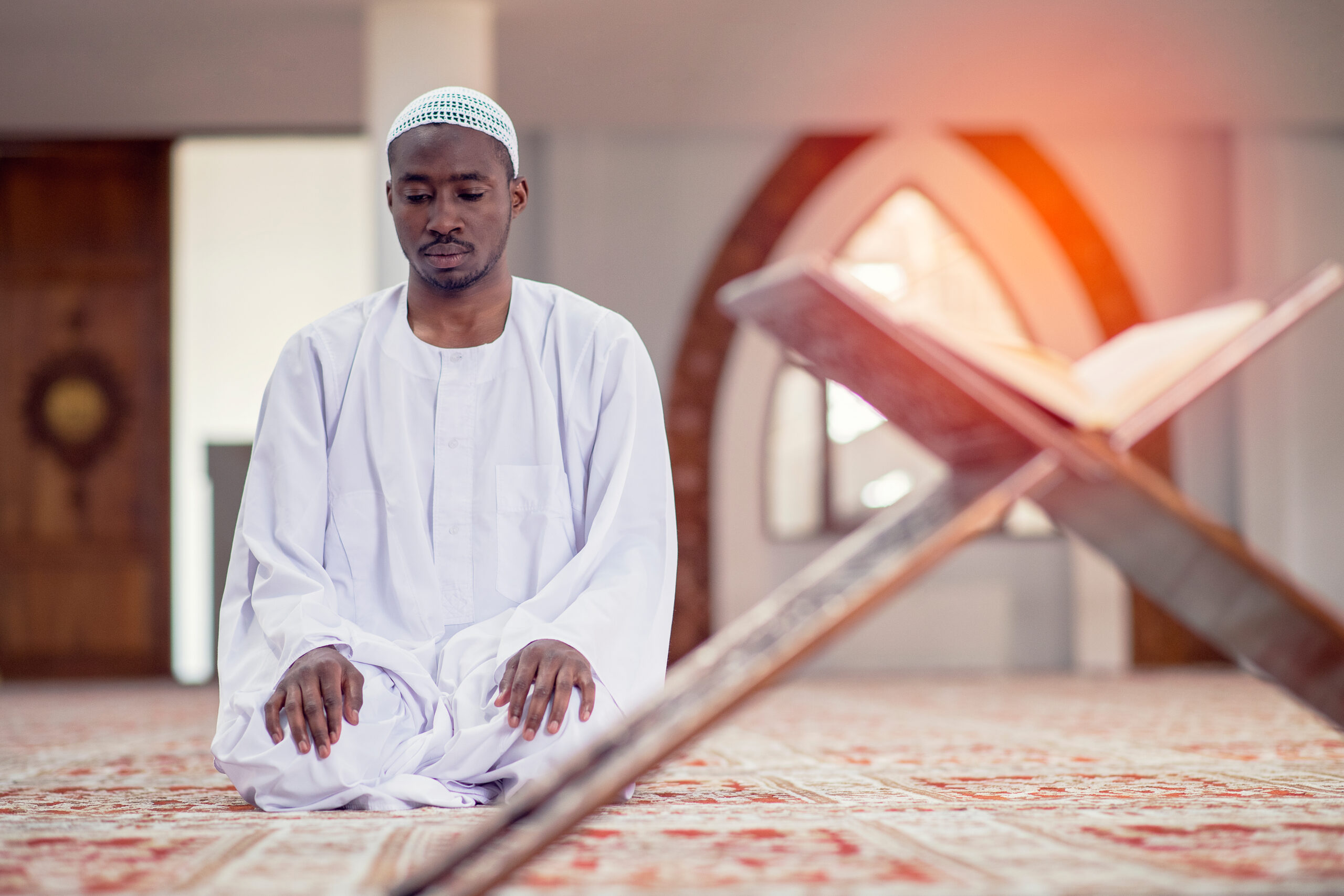Islam has attracted Africans since its earliest days

By Amina Abdulah
January/February 2023
Contrary to the belief that the history of black Muslims in the U.S. began with immigrants, the long-standing genealogy of their presence actually dates to the colonial period. This specific population, which now consists of almost 1 million people nationwide, “comprises the single largest ethnic group amongst Muslims in America” (Amina McCloud, “African American Islam,” 1995, 1). So why is this population so large, and how did they get here in the first place? To answer these questions, we must go back to the founding of Islam.
Soon after the revelation came to Prophet Muhammad (salla Allahu ‘alayhi wa sallam) in 610, Islam was first introduced into Africa by Muslims who left Makka in 615, upon the Prophet’s recommendation, to escape Qurayshi persecution. They went to Abyssinia (modern-day Ethiopia), where the Christian king welcomed them and allowed them to practice their religion freely. Some of the indigenous population converted. After this introduction, Islam began to spread throughout the continent.
The first substantial conversions began in East Africa. The sultans of regional countries encouraged migration to the East African coast for trade. These expats, however, never fully integrated with the Swahilis, whom they considered inferior. The Arabs separated themselves via an exclusive, culturally inspired version of Islam that angered the locals: “Swahilis cared nothing for Islamic revivalism or Pan-Islam, which bore an Arab stamp” (Randall L. Pouwels, ed., “History of Islam in Africa,” 2000, 18). Thus Islam didn’t spread beyond the coast until the 19th century, when Muslim merchants from the coast settled further inland and converted members of their entourage, relatives and employees.
In West Africa, where Islam was introduced later in the eighth century, it spread to virtually every major country. Kings became Muslim, and their people followed, to further trade with the Berbers, a group of North African Muslims, and to establish their nations, which grew steadily with the diplomatic bond forged from their shared Islamic identity. Uthman Ahmad states that “Contrary to what is commonly propagated, the religion of Islam (specifically in Africa) did not spread by the sword. The conversion of the people of these places to Islam was a process, extending over decades and sometimes centuries” (Uthman Sayyid Ahmad Al-Bili, “Some Aspects of Islam in Africa,” 2007, 35).
Although Muslim Africans did conquer other territories, they tolerated other religions as long as they didn’t turn against the ministry. Moreover, Islam was often incorporated into the people’s cultural aspects to make it more appealing. Over time, the religion started to affect everything from music to dress and became permanently intertwined in African culture. Al-Bili sums it up like this, “The greatest and most obvious aspect of the impact of Islam on Africa is certainly this: there are so many Muslims in Africa that the ratio of Muslims to all Africans is unrivalled by any other continent” (44).
West African rulers grew wealthier with trade, and with their conversion came the prestige of associating themselves with North African Muslims who had large established kingdoms. Europeans gradually heard the stories of these rulers’ wealth. One such story concerned Mansa Musa, the ruler of Mali (r. c. 1312 – c. 1337), who is said to have gone on a great pilgrimage in 1324 with a large caravan — 60,000 men and dozens of camels loaded with gold — that extended as far as the eye could see. His enormous wealth caused inflation when he traveled to the Egyptian city of Alexandria. The ruler’s opulence became so well known in Europe that he was illustrated on a medieval European map, The Catalan Atlas, holding a golden nugget. Some believe that this was one of the starting points that led to Europe’s subsequent colonization of Africa.
Two centuries later, when Africa was slowly being colonized by European invaders, the transatlantic slave trade began. Although there is some evidence of early Spaniard and African explorers possibly being Muslim, the best documented account of Muslim life in what would become the U.S. starts with the slave trade. From 1526 onward, roughly 12 million men, women, and children were captured, of which 10 million were transported to the U.S. The majority of all people enslaved in the New World were stolen from West Central Africa.
McCloud states that “it’s becoming increasingly clear through the translation and interpretation of Arabic slave narratives that a large portion of the Africans brought to this country as slaves were Muslims” (1). Some Muslims managed to retain their religion after being enslaved. However, Christianity was forced upon them during this time and many of their descendants lost touch with Islam’s spiritual side.
But Islam continued culturally through African American communities by parents giving their children Islamic and Arabic names like Bilal. According to Sylviane A. Diouf, “Islam in the Americas has been the religion of some people of African origin in an almost uninterrupted manner for the past five hundred years” (S. Diouf, “Servants of Allah: African Muslims Enslaved in the Americas,” 1998, ). Sadly, this population has been relatively small compared to the numbers of Muslim slaves who were brought here.
During the civil rights period (1954-68), Islam quickly began to grow again among African Americans. This period, one of great tremulation for black Americans, saw many needing a community to fall back on. The rise of movements like the Nation of Islam began to consolidate this need for belonging and spirituality. McCloud states, “Historically, Islam comes to already formed cultures, moralizes them, and directs them to the worship of God. For African American leaders, however, nationhood was not pregiven, and their primary concern was building a nation for their oppressed people” (39). The rise of Islam, particularly in connection with the Nation of Islam, was furthered by notable people like Muhammad Ali converting and joining the Nation, and Malcolm X, one of the country’s most notable civil rights leaders who, initially, was closely associated with the movement and preaching its values. The Nation of Islam declined, however, after his assassination in 1965, and the death of other prominent figures around the organization. Imam WD Mohammed led the Nation into (Sunni) Islam.
Although the Nation no longer has such a large influence on African Americans, the number of black Muslims continues to grow. Other events, namely 9/11, have unexpectedly engendered even more conversions by African Americans and Americans in general. Black Muslims have also founded strong Islamic communities, with the traditions of their forefathers and foremothers, that continue to nurture spiritual awareness among their youth. Although today the majority of black people in the U.S. are Christian, African Americans convert to Islam at a higher rate than they do to any other religion.
Amina Abdullah is an undergraduate student and freelance writer.
Tell us what you thought by joining our Facebook community. You can also send comments and story pitches to [email protected]. Islamic Horizons does not publish unsolicited material.
